I had a serious warning about loss of near memory lately, so want to record some special events in July now, in case I wipe them out. The first was a wonderful week in Brookings with Ann Di Salvo. We were in the middle of a searing hot spell that was undermining us all with weeks in the high 90s. Happily, the temp usually goes down to below 60 at night and sleep is still fine. Bruce bowed out at the last minute, to spend a week organizing a show he is having in the fall. He is working full time now at a print shop in Medford, and finding it impossible to free up time for art. We missed him, but had a great time nevertheless.
Our rental was adequate for basic needs but lacking in any special charm with one major exception. The side porch faced an extended thicket of shrubs and trees that afforded habitat for an amazing number of nesting birds. I have new hearing aids which vastly extend the distance and high range of what I can hear, and an app for my iPad that IDs songs of North American Birds with lots of examples of each. In the past 25 years I have lost many of the bird vocalizations used to know and recovering them is now a big part of my outdoor life. On arrival and after unpacking, we sat on the porch around 5PM to relax and look at our surroundings. I was also anxious to check out a new appon my iPad that has multiple songs of western birds. Immediately, a Swainson’s Thrush sang from very close by, from deep in the thicket. And altho it was mid-July, many males of other species were still singing and calling, including Black-headed Grosbeak and Purple Finch. And there was a White-crowned Sparrow singing his high and squeaky song from a wire in the distance – a good test for my new hearing aids. I found myself eager to get back from a hike in old growth or a beach walk at a minus tide, just to sit and listen and refresh my memory! It was a heady experience and my hat is off to technology for making such a positive change in the quality of my life.
Here is the the thicket, beyond which is the ocean.
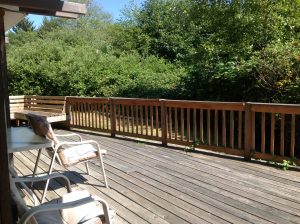
The app and new and effective hearing aids enhanced my birding skills tremendously, and by the end of our week I had a list of 23 species in the thicket alone, and had regained some of my erstwhile extensive knowledge of bird vocalizations. That alone would have been worth the trip. I’ve appended the list for any birders reading this.
We took some great hikes, one in a Redwood old-growth forest, another in old-growth Douglas fir, Sitka Spruce and Tanbark. Ann and I share difficulty in hiking so our pace is comparable. Slow – but we get there. I had a cortisone/lidocain shot in the groin a week before we went, and it put me back on my feet. I have an arthritic degenerated hip and it had gotten so bad I couldn’t even walk to the park to sit on Eric’s bench. The shot was miraculous, it may last 3 months and can be repeated.
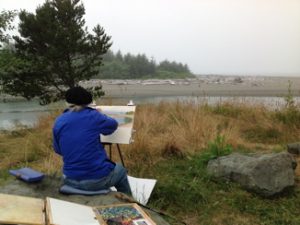
Plein air painting was also a delight and Ann did
two fine pastels, also in prep for a show.
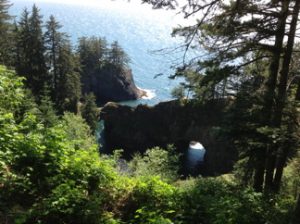
But I could not do a satisfactory watercolor, as has always been my case on the coast. The scenery is so breathtaking I guess the futility of representing it is overwhelming. Like this photo on the left. I took a lot of photos and did sketches and maybe they will work in a studio setting.
On our last day we went north to visit Kevin Christman, an Ashland artist who has bought into a new small resort on a bluff north of Gold Beach which will have 12 revitalized Airstream trailers for rent when done. Grand old Monterey Cypress trees dot the property and it looks exciting. Kevin is a fine and versatile artist (painting, sculpture, stained glass, etc.) and a long-time friend of Ann and Bruce.
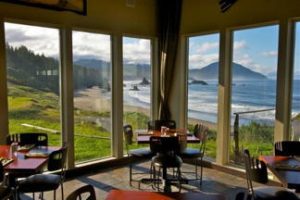
And then on to Port Orford to dine at Redfish, a wonderful quite new restaurant with a big Oregon reputation alfeady. It is on a bluff with a great view and we dined on halibut (it was opening day for halibut fishing). The meal lived up to its reputation and was all we could have wished for.
Another big event was a boat ride on Tule Lake to get closer to the grass/algae nesting area where thousands of Eared Grebes nest. I learned of this remarkable annual event only last year, happily in time to take a very good bird photographer there. But we had no boat and the nests were pretty far from the road, so our photos were not as sharp as we wished. Even so, we could identify Forster’s Tern, Redhead, Ruddy Duck, and Shoveler nests.
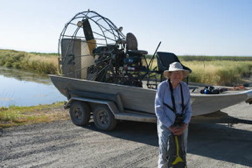
So this spring I asked John Beckstrand if we could somehow get out there by boat. He agreed and we set the date for July 18. We arrived ag 8AM to take advantage of early morning weather conditions. Therefuge uses an airboat to check the birds – it is noisy, clumsy, holds 4 passengers can’t brake or back up, and can’t get as close as we would have wished. But it does not get entangled in the grass and algae that grow thickly in mats on the lake in summer.
Last year we estimated thousands of nests from the road, and saw Forster’s Tern, Shoveler, Gadwall, Ruddy Duck and Western Grebe in among a huge population of Eared Grebes. But this July the nesting colony was clearly less than half as large and the only breeding bird other than Eared Grebe was Forster’s Tern. There were California Gulls and one Franklin’s Gull waiting around for a temporarily abandoned nest to rob. It was quite disappointing, as we had rented a long lens for the occasion and had high hopes for getting counts and some behavioral shots. What we learned was that consecutive seasons are not necessarily alike, something we should have been realized, as we are all experienced in field ornithology. I came home with the thought that this particular nesting phenomenon deserves serious study, and how I would love to do it if only my age would permit it. It is such a challenging and long-term project and I don’t know any likely candidate who would take it on. But at least I can delve into the ornithological literature and learn what others have learned about such nesting strategies.
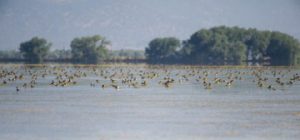
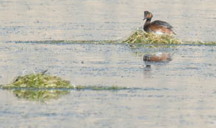
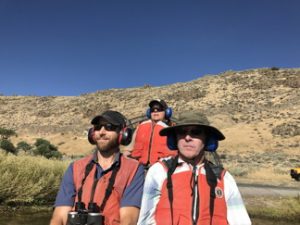
And finally, here is the latest mosaic, a gift to Jenny for her 65th birthday.
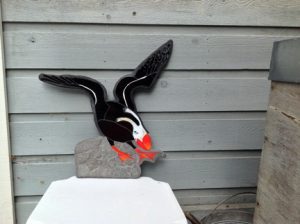
Appendix: bird list from the thicket (thanks, Heath,for the epithet).
Osprey, Bald Eagle, California Quail, Mourning Dove, European Collared Dove, Band-tailed Pigeon, Allen’s Hummingbird, Anna’s Hummingbird, Downy Woodpecker, Steller’s Jay, American Crow, Tree Swallow, Black-capped Chickadee, Bushtit, American Robin, Swainson’s Thrush ,Black-headed Grosbeak, Song Sparrow, White-crowned sparrow, House Finch , Purple Finch, American Goldfinch, Brewer’s Blackbird
